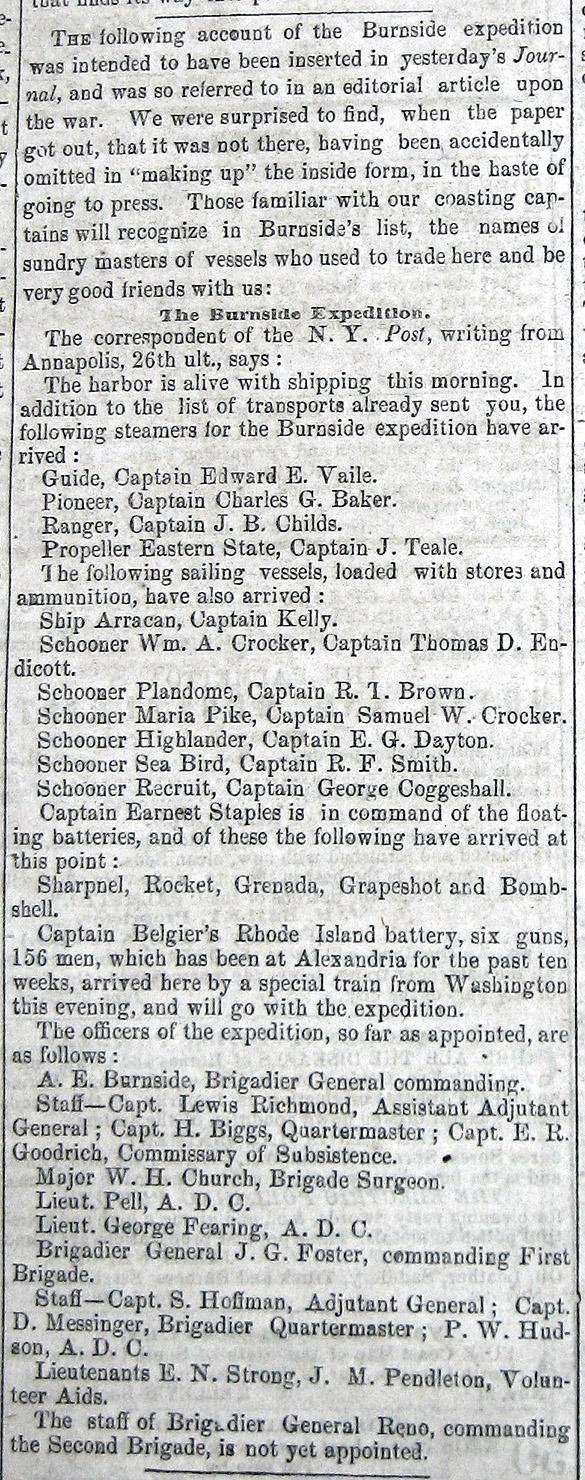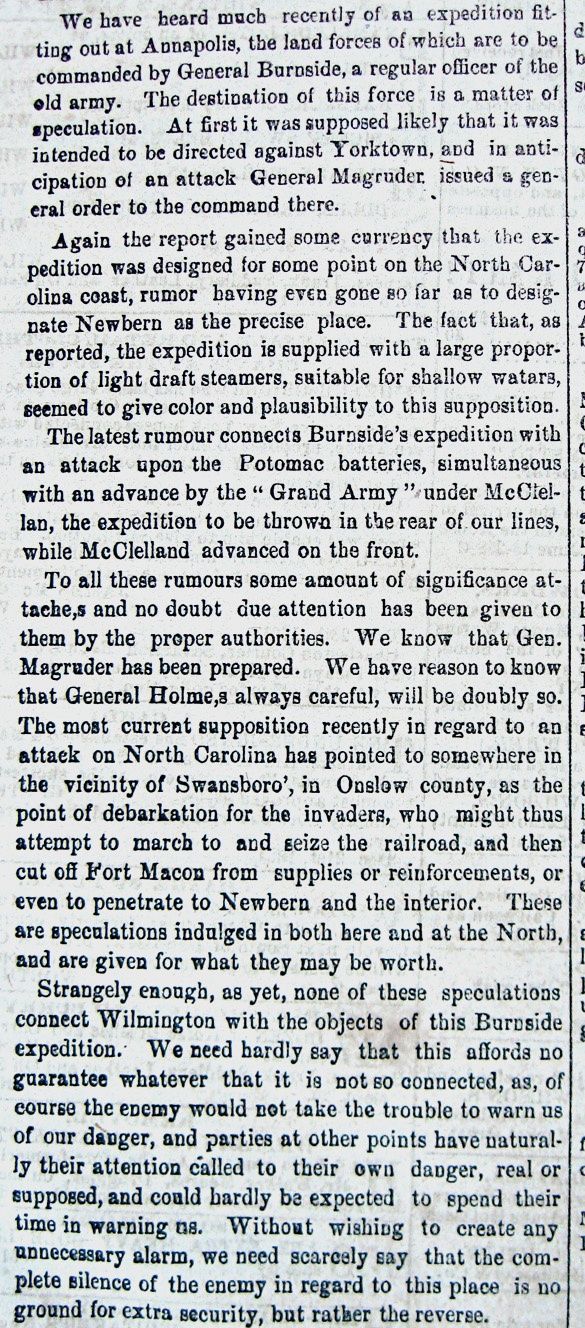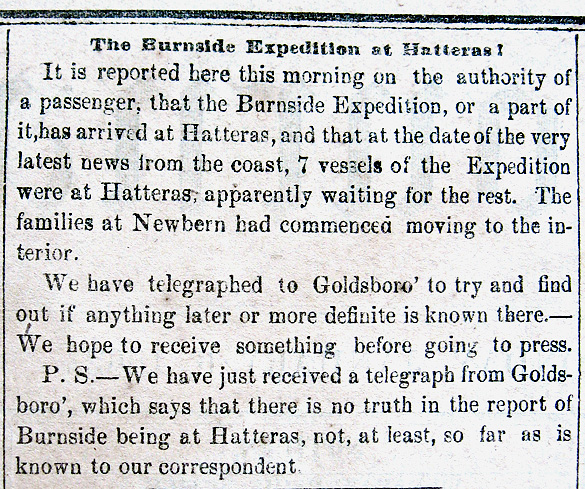Item Description: Newspaper article “The Burnside Expedition” from The Daily Journal (Wilmington, N. C.), page 2 column 2.

Transcription:
The following account of the Burnside expedition was intended to have been inserted in yesterday’s Journal, and was so referred to in an editorial article upon the war. We were surprised to find, when the paper got out, that it was not there, having been accidentally omitted in “making up” the inside form, in the haste of going to press. Those familiar with our coasting captains will recognized in Burnside’s list, the names of sundry masters of vessels who used to trade here and be very good friends with us:
The Burnside Expedition.
The correspondent of the N. Y. Post, writing from Annapolis, 26th ult. [26 December 1861], says:
The harbor is alive with shipping this morning. In addition to the list of transports already sent you, the following steamers for the Burnside expedition have arrived:
Guide, Captain Edward E. Vaile.
Pioneer, Captain Charles G. Baker.
Ranger, Captain J. B. Childs.
Propeller Eastern State, Captain J. Teale.
The following sailing vessels,loaded with stores and ammunition, have also arrived:
Ship Arracan, Captain Kelly.
Schooner Wm. A. Crocker, Captain Thomas D. Endicott.
Schooner Plandome, Captain R. T. Brown.
Schooner Maria Pike, Captain Samuel W. Crocker.
Schooner Highlander, Captain E. G. Dayton.
Schooner Sea Bird, Captain R. F. Smith.
Schooner Recruit, Captain George Coggeshall.
Captain Earnest Staples is in command of the floating batteries, and of these the following have arrived at this point :
Shrapnel Rocket, Grenada, Grapeshot and Bombshell.
Captain Belgier’s Rhode Island battery, six guns, 156 men, which has been at Alexandria for the past ten weeks, arrived here by special train from Washington this evening, and will go with the expedition.
The officers of the expedition, so far as appointed, are as follows:
A. E. Burnside, Brigadier General commanding.
Staff—Capt. Lewis Richmond, Assistant Adjutant General ; Capt. H. Biggs, Quartermaster ; Capt. E. R. Goodrich, Commissary of Subsistence.
Major W. H. Church, Brigade Surgeon.
Lieut. Pell, A. D. C.
Brigadier General J. G. Foster, commanding First Brigade.
Staff—Capt S. Hoffman, Adjutant General ; Capt. D. Messinger, Brigadier Quartermaster ; P. W. Hudson, A. D. C.
Lieutenants E. N. Strong, J. M. Pendleton, Volunteer Aids.
The staff of Brigadier General Reno, commanding the Second Brigade, is not yet appointed.
Item citation: “The Burnside Expedition,” The Daily Journal (Wilmington, N. C.), page 2 column 2. Call number , North Carolina Collection, Wilson Library, University of North Carolina at Chapel Hill.
Prologue and Additional information: Today’s post is the first, with others to follow, about the Burnside Expedition, which was an important Union military endeavor staged on sea and land, organized and led by Brigadier General Ambrose E. Burnside. Though the opening battle occurred in early February 1862, the endeavor began much earlier with roots reaching back to the summer of 1861. For a thorough account of the Burnside Expedition, see “A Succession of Honorable Victories”: The Burnside Expedition in North Carolina, by Richard A. Sauers (1996).
The above news article, as The Daily Journal editor apologized, was to have been published on 9 January 1862 (the previous day) “and was so referred to in an editorial article upon the war” in that edition. That editorial, “A Long or Short War—Other Things therewith Connected,” read in part:
Already the looks of the people are averted and their hearts turned away from their former idols at the “Great Norrard;” the course of the public and private men of that section and of its government has opened men’s eyes. Why, look at the list of transports in the Burnside expedition in to-day’s Journal, and see how many captains of the transports used to trade to this town and be such good friends of the South.
The 9 January editorial reference to the expedition was not the Daily Journal’s first, as rumors had already been circulating for some time. The first mention of the Burnside Expedition in The Daily Journal appeared in the 3 January edition within an editorial entitled “The General View of Things.” After analyzing the prospects of a major confrontation in Kentucky, the editorial turns to the following:
We have heard much lately of an expedition fitting out at Annapolis, the land forces of which are to be commanded by General Burnside, a regular officer of the old army.
The editorial continues by analyzing the possibilities. Civil War Day by Day presents the 3 January 1862 editorial below (without transcription) in order to provide our readers with the background information that readers of The Daily Journal already would have read.

A few days later on 6 January 1862 The Daily Journal published its first headline story on the subject—”The Burnside Expedition at Hatteras!”—just three days after the above editorial:

The short news item was indicative of the swirling rumors about the expedition and its location, with a corrective post script made right before going to press.
News (false) of the expedition’s whereabouts also appeared in the “By Telegraph” section of the Thursday, 9 January issue of the The Daily Journal:
Richmond, Va., Jan. 9th, 12 M.
Intelligence has been received at Norfolk, which states that Burnside’s Expedition was off Hatteras on Tuesday last.
As for a firsthand account, Private Newton Wallace of the 27th Massachusetts Infantry Company I, whose journal entries have appeared in prior Civil War Day by Day posts, wrote a one-sentence entry in Annapolis, Maryland on 9 January 1862:
I am getting along very well the expidition [sic] started today
Wallace, like almost every soldier at Annapolis, knew not where they were headed when the expeditionary forces left Annapolis at 7:30 A.M. Burnside had received his orders from General McClellan only two days earlier. At dawn on 10 January, the fleet sat anchored amidst dense fog just outside the mouth of the Potomac River. The fog lifted by early afternoon, and by afternoon’s end, the fleet reached Fort Monroe—with instructions to anchor and await further instructions. Shortly after 9:00 P.M., the ships set off toward Cape Henry, the Southern boundary of the entrance to Chesapeake Bay, where the captains opened their next set of instructions.
The expedition headed to Cape Hatteras.
Resource: “A Succession of Honorable Victories”: The Burnside Expedition in North Carolina, by Richard A. Sauers, (Dayton, Ohio: Morningside House, Inc.), 1996.

